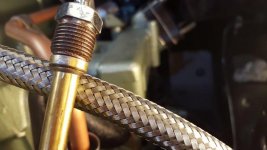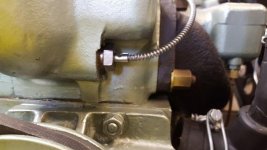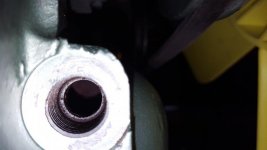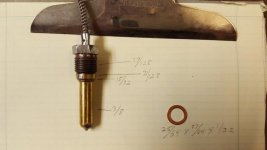RestoreThemAll
Jedi Warrior
Offline
Hey guys,
I sent my gauges to Nisonger for a full rebuild. Nice work. They installed a new water temp line and bulb. I cleaned up the threads in the head and used copper never seize. The nut screws in by hand all the way. I ground down an open end wrench and used it to tighten the nut. The line can be moved slightly, and I'm sure coolant will blow by. I've tightened the nut as much as possible with an open end wrench. This nut seems soft so I'm a little nervous about over tightening. I'm considering modifying a 5/8" deep well socket as suggested by some guys on this forum. How much do I dare torque this nut? 20#? More?
I could also put a tiny smear of sealer on the seat but at this point it's still too loose for that to cure the problem.
Dale
I sent my gauges to Nisonger for a full rebuild. Nice work. They installed a new water temp line and bulb. I cleaned up the threads in the head and used copper never seize. The nut screws in by hand all the way. I ground down an open end wrench and used it to tighten the nut. The line can be moved slightly, and I'm sure coolant will blow by. I've tightened the nut as much as possible with an open end wrench. This nut seems soft so I'm a little nervous about over tightening. I'm considering modifying a 5/8" deep well socket as suggested by some guys on this forum. How much do I dare torque this nut? 20#? More?
I could also put a tiny smear of sealer on the seat but at this point it's still too loose for that to cure the problem.
Dale

 Hi Guest!
Hi Guest!

 smilie in place of the real @
smilie in place of the real @
 Pretty Please - add it to our Events forum(s) and add to the calendar! >>
Pretty Please - add it to our Events forum(s) and add to the calendar! >> 







